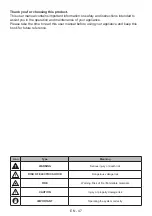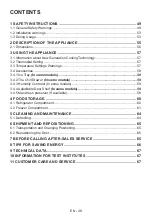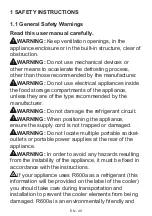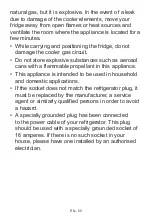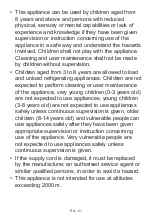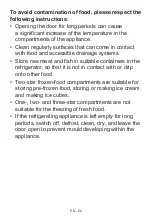
EN - 61
vegetables. (if available)
•
To prevent cross contamination, meat
products and fruit vegetables are not
stored together.
•
Foods should be placed in the refrigerator
in closed containers or covered to
prevent moisture and odors.
The table below is a quick guide to show
you the most efficient way to store the
major food groups in your refrigerator
compartment.
Food
Maximum
storage time
How and where to
store
Vegetables
and fruits
1 week
Vegetable bin
Meat and
fish
2 - 3 days
Wrap in plastic foil,
bags, or in a meat
container and store
on the glass shelf
Fresh
cheese
3 - 4 days
On the designated
door shelf
Butter and
margarine
1 week
On the designated
door shelf
Bottled
products
e.g. milk
and
yoghurt
Until the
expiry date
recommended
by the
producer
On the designated
door shelf
Eggs
1 month
On the designated
egg shelf
Cooked
food
2 days
All shelves
NOTE
:
Potatoes, onions and garlic should not
be stored in the refrigerator.
4.2 Freezer Compartment
For normal operating conditions, set the
temperature of the freezer compartment to
-18 or -20
o
C.
•
The freezer is used for storing frozen
food, freezing fresh food, and making ice
cubes.
•
Food in liquid form should be frozen
in plastic cups and other food should
be frozen in plastic folios or bags.For
freezing fresh food; wrap and seal fresh
food properly, that is the packaging
should be air tight and shouldn’t leak.
Special freezer bags, aluminum foil
polythene bags and plastic containers
are ideal.
•
Do not store fresh food next to frozen
food as it can thaw the frozen food.
•
Before freezing fresh food, divide it into
portions that can be consumed in one
sitting.
• Consume thawed frozen food within a
short period of time after defrosting
• Always follow the manufacturer's
instructions on food packaging when
storing frozen food. If no information is
provided food, should not be stored for
more than 3 months from the date of
purchase.
•
When purchasing frozen food, make sure
that it has been stored under appropriate
conditions and that the packaging is not
damaged.
•
Frozen food should be transported in
appropriate containers and placed in the
freezer as soon as possible.
•
Do not purchase frozen food if the
packaging shows signs of humidity
and abnormal swelling. It is probable
that it has been stored at an unsuitable
temperature and that the contents have
deteriorated.
•
The storage life of frozen food depends
on the room temperature, the thermostat
setting, how often the door is opened,
the type of food, and the length of time
required to transport the product from
the shop to your home. Always follow the
instructions printed on the packaging and
never exceed the maximum storage life
indicated.
•
If the freezer door has been left open for
a long time or not closed properly, frost
will form and can prevent efficient air
circulation. To resolve this, unplug the
freezer and wait for it to defrost. Clean
the freezer once it has fully defrosted.
•
The freezer volume stated on the label is
the volume without baskets, covers, and
so on.

